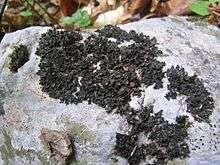Foliose lichen


A foliose lichen is one of a variety or lichens, which are complex organisms that arise from the symbiotic relationship between fungi and a photosynthetic partner, typically algae. This partnership allows lichen to live in diverse climates that can range from cold, dry mountains to wet, warm valleys. Lichens develop quite slowly with recorded growth rates of 0.01-27mm/year depending on the species. Their lifespan averages between 30 and 60 years (Armstrong & Bradwell pg.3).
Lichens have a main body part called the thallus, which is composed of hyphae, and houses the cortex and medulla. The cortex contains the photosynthetic cells while the medulla allows for gas exchange and makes up the bulk of the lichen's thallus. There are three main types of lichens: crustose, foliose, and fruticose. Foliose lichen are characterised by flattened leafy thalli, and an upper and lower cortex. Many have numerous layers, which are stratified, and aid in identifying different types.
Foliose lichens attach to surfaces by hyphae in the lower cortex with smaller root like structures called rhizines (Lichens of North America Pg 3, 13). Lichens play an important role environmentally. They provide a food source for many animals such as deer, goats, and caribou, and are used as building material for bird nests. Some species can even be used in antibiotics. They are also a useful indicator of atmospheric pollution level. (Daniel and Nicholas)
Pollution
There is a direct correlation between pollution and the abundance and distribution of lichen. Foliose lichens are extremely sensitive to sulphur dioxide, which is a by-product of atmospheric pollution. Sulphur dioxide reacts with the chlorophyll in lichen, which produces phaeophytin and magnesium ions. When this reaction occurs in plants the lichen will then have less chlorophyll causing a decrease in respiration which eventually kills the lichen (Hill 831–836).
Weathering of Rocks
Minerals in rocks can be weathered by the growth of lichens on exposed rock surfaces. This can be attributed to both physical and chemical processes. Lichen can chemically weather minerals such as calcite by producing organic acids like oxalic acid. This reacts with minerals in the rock, dissolving them and weakening the rock. As a result of this many rocks that have or once had lichen growth exhibit extensive surface corrosion. By-products of this weathering are poorly ordered iron oxides and amorphous alumino-silica gels, the neoformation of crystalline metal oxalates and secondary clay minerals. Lichen physically weather rocks by penetrating the rock's small crevasses with their rhizoids. The expansion and contraction of the roots causes smaller cracks to expand. (Chen, Jie, Hans P. Blume, and Lothar Beyer).
Reproduction
The reproduction of foliose lichen can occur either asexually or sexually. The sexual reproduction requires both a fungal and photosynthetic partner. The photobiont once in symbionce with its fungal partner will not produce recognisable reproductive structures therefore it is up to the fungal partner to continue reproduction for the lichen. In order for lichen reproduction to take place the fungal partner must produce millions of germinating spores which fuse to from a zygote that must then also find a compatible photobiont. This photobiont will fuse with the zygote and live within the fungi creating a lichen. The fungal partner in most foliose lichen are ascomytes with spores called ascomata. The fruiting bodies of lichen typically make up one of two shapes. Apothecia which look like disk or cup shaped and produce their spores on their upper surface. And perithecia which are shaped like flasks that enclose a spore producing layer with a hole at the top ( Brodo, Sharnoff, and Sharnoff). Since sexual reproduction is inefficient, lichen will reproduce asexually by vegetative reproduction when possible. Foliose lichen use isidia which are cylindrical finger like protuberances from the upper cortex in which algal and fungal tissue is incorporated into. They are easily broken off and transported by wind where they will relocate and propagate forming a new lichen (Easton pg.62).
Environment and Fecundity
The life history strategies of foliose lichens is directly related to their surrounding communities. Studies have shown a shift from sexual to vegetative communities with changes in environment. It was found that if sexual reproduction is important for allelic diversity then habitats with high levels of disturbance would have species with rapid life cycles and high reproductive output to better respond to the changing habitat. Three types of foliose saxicolous lichen were chosen for a study because they each dominated different communities. They included Arctoparmelia centrifuga, Xanthoparmelia viriduloumbrina, and Xanthoparmelia cumberlandia and resemble stress tolerant, competitive and ruderal species relative to the communities they dominate. Xanthoparmelia viriduloumbrina is considered to be stress tolerant because it occurred in the open mossy rock community and had a lower reproductive output. The high amount of rock weathering and few vascular plants indicate that the mossy rock community is an exposed habitat. Xanthoparmelia cumberlandia had vegetative dominance in the grassy rock community which had moderate exposure compared to the other communities. In a more exposed community this species showed the second highest dominance and high apothecia, indicating that it is a ruderal species. Arctoparmelia centrifuga dominated in the treed rock environment which has the greatest species diversity and was the most competitive environment. A. centrifuga had a high abundance and reproductive output in this environment, suggesting it is a competitor. Despite these differences in species richness the study shows that there is uniformity between the proportion of sexual and asexual propagules for macrolichens between communities.
Light Exposure and Growth

The success of foliose lichen, especially old-growth forest lichen is dependent on the amount of light in the surrounding environment which dictates a delicate balance between growth potential and desiccation damage. Lobaria pulmonaria is an old-growth forest lichen which was transplanted to three different boreal forest stands to assess its biomass and area growth. The three stands had different amounts of light exposure, moistening and nutrient additions. The three forest habitats included (1) even-aged young and closed canopy stand, (2) old forest with gaps, (3) open clear-cut areas with sparse regeneration of scattered trees with no self shading branches. Each of these environments offered varying amounts of light exposure. Growth of L. pulmonaria was highest in open sites, in which the species normally does not occur naturally. Lack of light seems to be a strong limiting factor for the growth of L. pulmonaria. However, there is no simple relationship between site factors and light especially because lichens desiccate at different times of the day. At the same time, L. pulmonaria has a low tolerance to prolonged high light, during desiccation times it can neither repair damage nor acclimate.
References
- Brodo, Irwin M., Sylvia D. Sharnoff, and Stephen Sharnoff.
- "Lichens of North America." Google Books. Canadian Museum Of Nature, n.d. Web. 07 Nov. 2015. <https://books.google.ca/books?id=YyS-hS15Ty4C&pg=PA13&dq=foliose%2Blichen&hl=en&sa=X&ved=0CCQQ6AEwAGoVChMIm-bc7IX4yAIVQls-Ch1WwgCD#v=onepage&q=foliose%20lichen&f=false>.
- Bradwell, Tom; Armstrong, Richard A. "Growth of Foliose Lichens: A Review". Symbiosis. 53: 1–16. doi:10.1007/s13199-011-0108-4.
- Chen, Jie; Blume, Hans P.; Beyer, Lothar. "Weathering of Rocks Induced by Lichen Colonization — a Review". CATENA. 39: 121–146. doi:10.1016/S0341-8162(99)00085-5.
- Daniel, George H., and Nicholas Polanin. "Tree-Dwelling Lichens." (from Rutgers NJAES). Rutgers, The State University of New Jersey, n.d. Web. 07 Nov. 2015. https://njaes.rutgers.edu/pubs/fs1205/
- Deduke, C., T. Booth, and M.d. Piercey-Normore. "Lichen Fecundity on the Precambrian Shield: An Alternative Life History Strategy Approach."NRC Research Press: -35. Print.
- Easton, R.M. "Lichens and Rocks: A Review | Easton |
- Geoscience Canada." Lichens and Rocks: A Review | Easton | Geoscience Canada. Ontario Geological Survey. Web. 8 Nov. 2015 https://journals.lib.unb.ca/index.php/GC/article/view/3831/4345
- Fenton, A. F. Lichens as Indicators of Atmospheric Pollution. 7th ed. Vol. 13. N.p.: Irish Naturalists' Journal, 1960. 153-59. Print transferred to e-text. http://www.jstor.org/stable/pdf/25534710.pdf?acceptTC=true
- Gauslaa, Yngvar, Marit Lie, Knut Asbjørn Solhaug, and Mikael Ohlson. "Growth and Ecophysiological Acclimation of the Foliose Lichen Lobaria Pulmonaria in Forests with Contrasting Light Climates." Oecologia (2005): 406-16. Print.
- Hill, D. J. "EXPERIMENTAL STUDY OF THE EFFECT OF SULPHITE ON LICHENS WITH REFERENCE TO ATMOSPHERIC POLLUTION". New Phytologist. 70: 831–836. doi:10.1111/j.1469-8137.1971.tb02583.x.